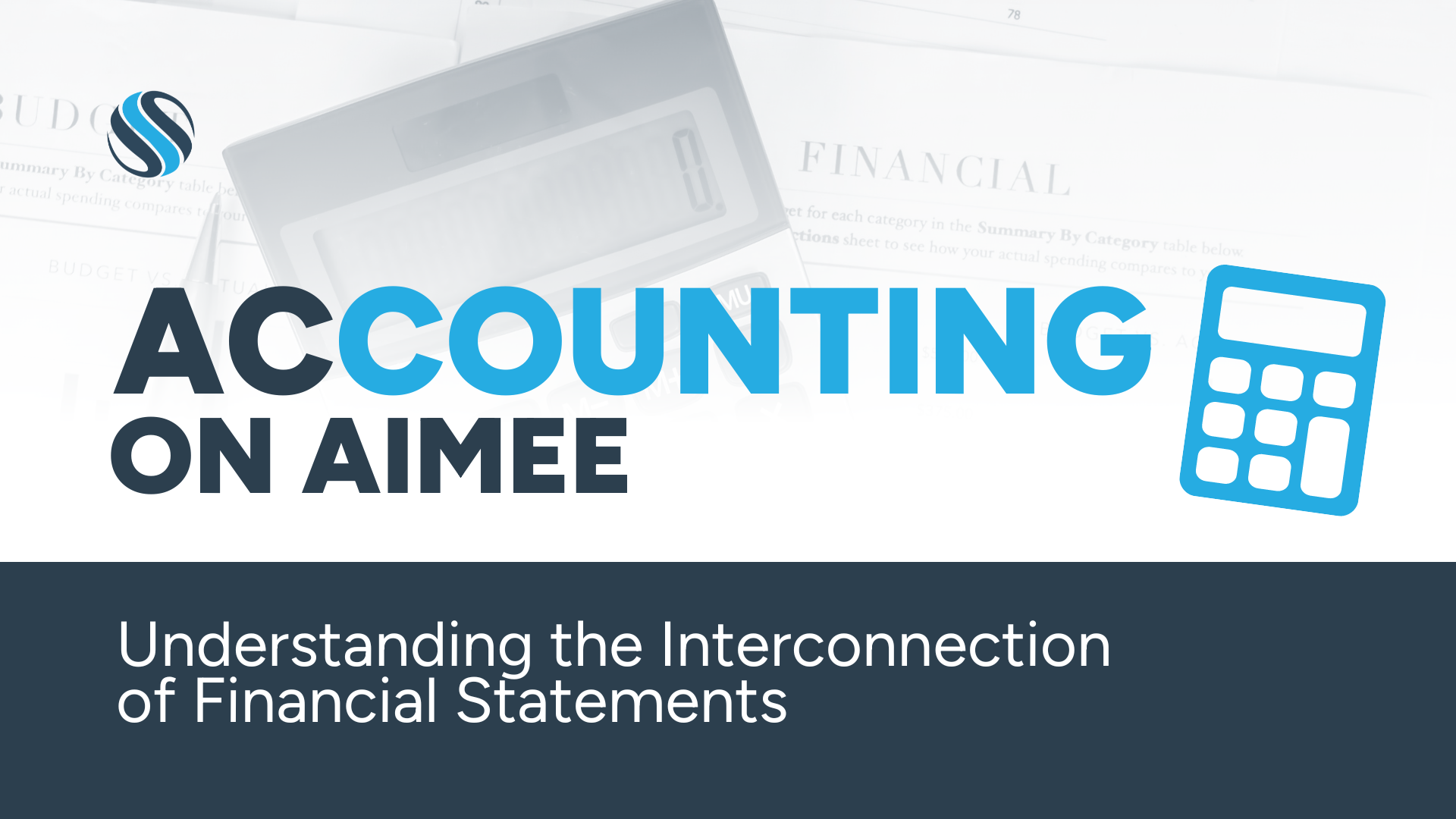
26 Aug AcCOUNTING on Aimee: Understanding the Interconnection of Financial Statements
Financial statements are essential tools that offer a window into the health and performance of a business in the world of finance. While each financial statement serves a specific purpose, its real power is revealed when they are analyzed together. Understanding how the Income Statement, Balance Sheet, and Cash Flow Statement are interconnected is crucial for anyone involved in financial decision-making. Whether you’re an investor assessing the viability of a potential investment, a manager making strategic decisions, or an accountant preparing reports, grasping these connections will enable you to see the complete financial picture of a company.
The Income Statement: A Measure of Profitability
The Income Statement, often called the Profit and Loss Statement, is the most straightforward of the three financial statements. It summarizes the company’s revenues, costs, and expenses over a specific period, usually quarterly or annually. The Income Statement ends with the net income, a critical figure that shows the company’s profit or loss for the period.
Key Components:
- Revenue: Total income generated from selling goods or providing services. It’s the starting point of the Income Statement.
- Cost of Goods Sold (COGS): Direct costs attributable to the production of goods sold. Subtracting COGS from revenue gives the Gross Profit.
- Operating Expenses: These are the day-to-day expenses incurred in running the business, including rent, utilities, and wages.
- Operating Income: This is Gross Profit minus Operating Expenses, indicating the profitability of the company’s core business activities.
- Net Income: After accounting for all expenses, including taxes and interest, this figure shows the company’s overall profitability.
The Income Statement is crucial for evaluating a company’s profitability and operational efficiency. It answers critical questions like Is the company making a profit? How well is it controlling its costs? However, to fully understand its implications, we must connect it to the Balance Sheet and Cash Flow Statement.
The Balance Sheet: A Snapshot of Financial Health
The Balance Sheet provides a snapshot of a company’s financial position at a specific point in time. Unlike the Income Statement, which covers a period, the Balance Sheet is static, showing what the company owns and owes at a particular moment.
Key Components:
- Assets: These are the resources owned by the company. Assets are categorized into current assets (e.g., cash, accounts receivable) and non-current assets (e.g., property, equipment).
- Liabilities: These are obligations the company owes to others. Like assets, liabilities are divided into current liabilities (e.g., accounts payable, short-term debt) and non-current liabilities (e.g., long-term debt).
- Shareholders’ Equity: This represents the owners’ residual interest in the company after liabilities are subtracted from assets. It includes retained earnings and common stock.
The Balance Sheet reveals the company’s liquidity, solvency, and financial stability. It shows how well the company can meet its short-term obligations (liquidity) and how it’s financed (through debt or equity). However, the Balance Sheet alone doesn’t provide the complete picture. To understand how assets and liabilities change over time and how they impact cash flows, we need to look at the Cash Flow Statement.
The Cash Flow Statement: The Lifeblood of Business
The Cash Flow Statement tracks the flow of cash into and out of the company over a period. It’s divided into three sections: operating activities, investing activities, and financing activities.
Key Components:
- Operating Activities: This section adjusts net income for non-cash items like depreciation and changes in working capital. It shows the cash generated or used by the company’s core business operations.
- Investing Activities: Here, cash flows related to the purchase or sale of assets, such as equipment or investments, are recorded.
- Financing Activities: This section includes cash flows from borrowing or repaying debt, issuing or repurchasing stock, and paying dividends.
The Cash Flow Statement is vital because it shows the company’s ability to generate cash to fund its operations, pay debts, and invest in growth. While the Income Statement may show a profit, it’s the Cash Flow Statement that reveals whether the company is actually generating enough cash to sustain itself. The connection between the Cash Flow Statement and the other financial statements is crucial for understanding the company’s financial health.
The Interconnection of Financial Statements: A Holistic View
To truly understand a company’s financial performance, it’s essential to see how the Income Statement, Balance Sheet, and Cash Flow Statement are interconnected. These statements don’t exist in isolation; they inform and affect each other in several critical ways.
Net Income and Shareholders’ Equity
Net income from the Income Statement directly affects the Balance Sheet through retained earnings, a component of shareholders’ equity. Retained earnings represent the cumulative net income that has been reinvested in the business rather than paid out as dividends. When a company earns a profit, its retained earnings increase, thereby increasing shareholders’ equity on the Balance Sheet. Conversely, a net loss decreases retained earnings and equity.
Depreciation and Asset Valuation
Depreciation is a non-cash expense that reduces net income on the Income Statement. It’s also reflected on the Balance Sheet as a reduction in the book value of assets over time. However, because depreciation doesn’t involve an actual cash outflow, it’s added back to net income in the operating activities section of the Cash Flow Statement. This adjustment highlights how the same figure—depreciation—affects all three statements: reducing net income, decreasing asset values, and influencing cash flow.
Working Capital and Cash Flow
Working capital, defined as current assets minus current liabilities, is a key indicator of a company’s short-term financial health. Changes in working capital components, such as accounts receivable, inventory, and accounts payable, are reflected on both the Balance Sheet and Cash Flow Statement. For example, an increase in accounts receivable indicates that the company has made more sales on credit, which boosts revenue on the Income Statement but reduces cash flow because the cash hasn’t yet been received. This interplay between working capital and cash flow is crucial for understanding the company’s liquidity.
Capital Expenditures and Long-Term Investments
When a company invests in long-term assets, such as new equipment or property, it’s reflected in multiple financial statements. The purchase of these assets increases non-current assets on the Balance Sheet and is recorded as a cash outflow in the investing section of the Cash Flow Statement. If the company finances the purchase through debt, this also increases liabilities on the Balance Sheet. The interest expense from the debt then appears on the Income Statement, reducing net income. This example illustrates how a single transaction can ripple across all three statements, affecting assets, liabilities, equity, cash flow, and profitability.
Dividends and Share Buybacks
Dividends paid to shareholders are deducted from retained earnings on the Balance Sheet and are shown as cash outflows in the financing activities section of the Cash Flow Statement. Similarly, share buybacks reduce shareholders’ equity by decreasing the number of outstanding shares and are also recorded as a financing outflow. These activities show how decisions to return value to shareholders impact both the company’s equity and its cash reserves.
Inventory and Cost of Goods Sold (COGS)
Inventory management is another area where financial statements intersect. When a company purchases inventory, it increases current assets on the Balance Sheet. As this inventory is sold, it’s recognized as Cost of Goods Sold (COGS) on the Income Statement, reducing net income. At the same time, selling inventory reduces inventory levels on the Balance Sheet. Effective inventory management can therefore improve profitability and cash flow, underscoring the interconnected nature of these financial elements.
Understanding the interconnection of financial statements is fundamental to accurate financial analysis and sound decision-making. Each statement—the Income Statement, Balance Sheet, and Cash Flow Statement—provides unique insights into different aspects of a company’s financial health. However, it’s only by considering them together that one can truly grasp the complete financial picture.
For investors, managers, and other stakeholders, recognizing these interconnections is key to understanding how a company’s operations, financial position, and cash flows relate to each other. Whether evaluating investment opportunities, managing business performance, or preparing for financial reporting, this holistic approach to financial statements enables more informed decisions and better strategic planning.
By mastering the relationships between the Income Statement, Balance Sheet, and Cash Flow Statement, you gain the ability to not only assess past performance but also predict future financial outcomes, positioning yourself and your business for long-term success.

























